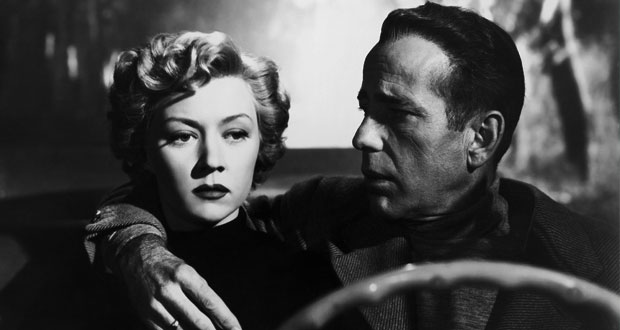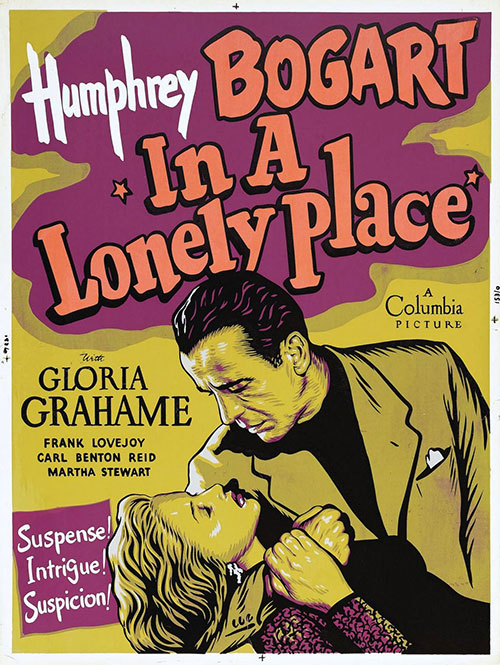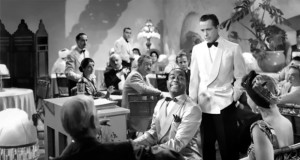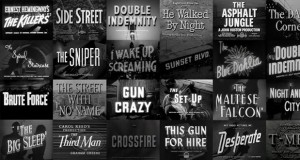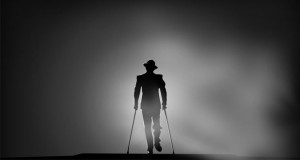Director: Nicholas Ray
Writer: Andrew Solt
Cast: Humphrey Bogart, Gloria Grahame, Frank Lovejoy
This review contains major spoilers.
I didn’t notice In A Lonely Place when I first got hooked on noir films. I overlooked it as it didn’t have the same reputation that The Maltese Falcon, The Big Sleep or Sunset Boulevard had.It was only when I had worked my way through all the best known noir classics and wanted more that I happened across this gem. In A Lonely Place ranked #1 in a list compiled by self styled ‘noirchaelogist’ Eddie Muller and its description as a particularly dark, personal film caught my attention.
Directed by Nicholas Ray, the film stars Humphrey Bogart as temperamental Hollywood writer Dixon Steele. Steele is down on his luck and is described as having gone without a big hit ‘since before the war’. We get a sense for his short fuse when he almost gets involved in an altercation with another motorist at a set of lights (is this Hollywood’s earliest onscreen instance of road rage?) and again when he meets his agent at a night club to discuss a possible film project and instead he ends up punching out a young director who bad mouths his friend.
Dixon is sent home with a book to read to adapt into a screenplay but he complains that he is too tired to finish it. This draws the attention of the cloakroom attendant Mildred who offers to read it aloud to him. She does so and then when Dixon determines the book to be of dubious quality, he sends her home in a taxi. Hours later, Dixon is called in by the police for questioning. Mildred was found murdered and Dixon was the last known person to have seen her.
Did Dixon commit foul play? He is given an alibi by his neighbor Laurel Gray who passed Dixon and Mildred when they entered the apartment. She then sees him again through the window to his bedroom. She can vouch for his whereabouts and that there was no arguments or disturbances with Mildred. Laurel’s testimony frustrates Captain Lochner of the police force who mistrusts Dixon and is convinced he has the temperament and means to kill Mildred. To complicate matters further, Dixon and Laurel develop a romantic relationship and Lochner is terrified that she will meet a similar fate.
Did Dixon kill Mildred? If he didn’t, who did? Is Laurel completely trustworthy? And what about the Captain. Is he genuinely interested in solving Mildred’s murder or is he looking for someone to pin the crime on?
These are some of the thoughts that ran through my head because that’s how noir works. The familiar tropes that we associate with the genre suggest that someone is being deceptive and has an ulterior motive for their actions. We know what we saw but in the back of our minds we wonder whether Dixon could have slipped away to kill Mildred or if Laurel and Dixon are in cahoots even though it doesn’t seem possible.
What makes In A Lonely Place such a chilling and effective film is that it doesn’t dabble with the more sensationalist tropes associated with film noir. Instead the reality is much simpler, starker and disturbing. It hits you when Dixon is invited to have dinner with his agent Brub and Brub’s wife. Although he stands by his innocence, he postulates on Mildred’s murder and has a disturbing gleam in his eye when he talks about turning a loving embrace into an act of strangulation. Laurel herself begins to have doubts about Dixon when he is incensed to learn that he is still a police suspect and speeds along the freeway, side swiping another car in the process. When the driver accosts him, he comes within inches of beating the man to death with a rock.
The reality that dawns on the agent, on Laurel and on the viewer is that it doesn’t matter whether Dixon murdered Mildred. His violent and unchecked temper makes him a threat to those close to him, whether he killed before or not.
Although film noir deals with ‘dark’ subject matter, it commonly does so in a style involving fantastical characters such as power hungry mobsters, femme fatales and murderous adulterers. They are entertaining to watch but seldom scary or genuinely affecting as they are clearly works of fiction. When In A Lonely Place is viewed through a modern lens as a film about a woman who is trapped and threatened by a man who is capable of domestic violence, it takes the film in a more grounded, realistic direction that the genre seldom treads. There is a scene near the conclusion of the film where Dixon, Brub and Laurel are sitting together in a dining booth at a restaurant. Laurel desperately wants to leave Dixon but the story she has concocted to run away from him begins to unravel. It is the most intense and unnerving scene in the entire picture. Just when the tension is raised to the point where you can’t stand it, the final scene takes places and Dixon crosses a line he can’t walk back. The phone rings. He is cleared of Mildred’s murder but it is too late. It is a gut wrenching finale.
Review Overview
RATING
CLASSIC
Summary : A disturbing film noir featuring one of Humphrey Bogart's darkest performances. An underrated gem.
 The FAT Website est. 1999
The FAT Website est. 1999

